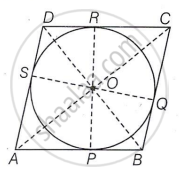Advertisements
Advertisements
Question
Prove that the parallelogram circumscribing a circle is a rhombus. Also, find the area of the rhombus, if radius of circle is 3 cm and length of one side of the rhombus is 10 cm.
Solution
Given ABCD, be a parallelogram circumscribing a circle with centre O.
ABCD is a rhombus.

We know that the tangents drawn to a circle from an exterior point are of equal length.
∴ AP = AS, BP = BQ, CR = CQ and DR = DS
Adding the above four equations
AP + BP + CR + DR = AS + BQ + CQ + DS
(AP + BP) + (CR + DR) = (AS + DS) + (BQ + CQ)
∴ AB + CD = AD + BC
∴ 2AB = 2AD ...[since AB = DC and AD = BC of parallelogram ABCD]
∴ AB = BC = DC = AD
Therefore, ABCD is a rhombus.
Join OC, OP, OQ, OR, OD, OS, OB and OA
Now, the area of rhombus = Area of ΔBOC + Area of ΔAOB + Area of ΔAOD + Area of ΔCOD
Area of ΔBOC = `1/2 xx BC xx OQ` ...[∵ Area of triangle = `1/2 xx "Base" xx "Height"`]
= `1/2 xx 10 xx 3`
= 15 cm2
∴ Area of ΔBOC = Area of ΔAOB
= Area of ΔAOD
= Area of ΔCOD
= 15 cm2
∴ Area of rhombus = 4 × Area of ΔBOC
= 4 × 15 cm2
= 60 cm2
Therefore, the area of the rhombus is 60 cm2.
